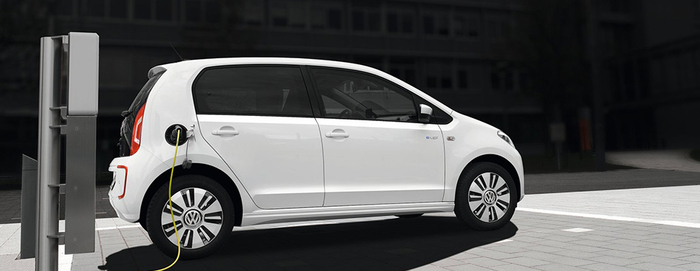Volkswagen e-Up!

We went to Milton Keynes to drive the Yorkshire Volkswagen, the e-Up! – the electric version of the VW Up! Obviously the product or model naming department in Germany have never heard of Yorkshire or their well-known phrases.
The e-Up! is powered by a 60 kW or 80hp electric motor, which is installed under the bonnet in the standard engine compartment where it drives the front wheels. It accelerates from 0 - 37mph in 4.9 seconds and to 0 - 62mph in 12.4 seconds and goes on to a top speed of 81 mph. This is in comparison the 1.0 75ps petrol version of the Up!, which accelerates from 0 - 62mph in 13.2 seconds and can go on to a top speed of 106 mph. The electric motor produces an impressive 210Nm of torque which compares to the just 95Nm for the 1.0 75ps petrol version.

The lithium-ion battery pack, which supplies the power to the electric motor, weighs in at 230kg and is made up of 17 modules each with 12 cells. The battery pack is rated at 18kWh. The battery pack, which is 1726mm long and 1132mm wide, lies flat within the car’s floor between the front and rear seats.
The e-Up! can be charged from a standard household 13 amp three pin socket using the cable provided. It can be fully charged in 9 hours. An optional wall box for home garage use provides 3.6kW supply and can recharge a completely discharged battery in 6 hours. Using a standard combined charging system (CCS) and DC supply the e-Up! can be charged to 80% capacity in 30 minutes. The official range on a full charge is around 100 miles, but in reality, 70 miles is a more realistic figure.
The complex power electronics system weighs 10.5 kg and controls the flow of high voltage power between the e-motor and the lithium-ion battery pack. This module includes a motor invertor control circuit board, the DC/DC convertor, a DC link capacitor and a controller board. All very technical and not the sort of thing your average mechanic would be able to repair. But VW, like other EV manufacturers do have specialists in this field. They are all fully trained for any eventuality and are able to keep the car on the road. Only 24 out of the total of 208 dealers are electric car outlets.

We took to the road in the e-Up! around Milton Keynes and it proved to be quick and efficient. The automatic gearbox was appreciated with all those roundabouts to go around. The handling seemed to be just as good as the petrol version and with all that weight so close to the floor, it would probably be even better on twistier, more challenging roads.
The e-Up! is easy to drive and understand, just put it into Drive (D) to go forward and Reverse (R) to go backwards and away it goes, quickly and quietly. But to complicate it a bit there is also D1, D2, D3 and B. In D, the car coasts without regenerative braking when the accelerator is lifted. In each of the next levels, lifting off the accelerator pedal provides an increased level of regenerative braking. In D2, D3 and B, the brake lights are automatically activated when the driver’s foot is lifted from the accelerator pedal, which could be confusing, or dangerous for vehicles following. It is perhaps best just to leave it in D for safety, in my opinion.
The e-Up! Is only available as a five-door and uses the top specification from the petrol version the High-Up!, so it’s fully loaded and you would want for nothing else in a small car. The list of standard specification is endless and far too long to mention.

From the exterior the e-Up! looks very similar to the Up!, but with some small unique features, such as different alloy wheels, blue-backed chrome VW roundels, a discreet ‘e-Up!’ badge and some very nice and distinctive LED day running lights.
The e-Up! is built in Volkswagen’s Bratislava plant in Slovakia and has a standard 3 year or 60,000 mile warranty, with an additional 8 year or 100,000 mile battery pack warranty.
The e-Up! is priced at £24,250 OTR, less the current EV Government grant of £5,000, making it £19,250. This does seem expensive compared to the petrol equivalent which is nearly half the price. But running costs for the electric version are minimal and the savings will offset some of the extra capital cost, although having to refuel every 70 miles as opposed to around every 400 miles, for the petrol version, may cause some potential buyers a problem.
Martin Ward, Manufacturer Relationship Manager


